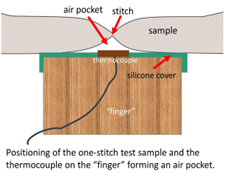Heat transfer test method development: Consideration for design and safety of household oven mitts
DOI:
https://doi.org/10.25367/cdatp.2024.5.p207-221Keywords:
textile testing, heat transfer, oven mitts, burn injuriesAbstract
The purpose of this study was to develop a test method – an apparatus and a protocol for evaluating the rate of heat transfer across a sample of layered materials commonly used in oven mitts. Using the apparatus, effects of contact temperature and pressure as well as design features such as quilting stitching pattern of the sample on heat transfer were examined. The apparatus featured a round wooden base with three silicone-covered wooden “fingers” equipped with thermocouples where the test samples were mounted. The device was lowered with the samples down onto a hot plate kept at stable high “pan” contact temperature. Upon contact, changes of the “skin” contact temperatures (at the “fingers”) were recorded at 10 Hz for 300 s. Tests were carried out at six levels of pressure on the sample (exerted by variable weights), 3 levels of “pan” contact temperature, and 3 different quilting stitch patterns of the material. Time to reach critical skin threshold temperature was affected by stitch pattern; it decreased exponentially with increasing pressure and increasing hot plate contact temperature. The shape of the temperature-time curve indicated how the material configuration of the sample affects the transfer of heat.
References
United States Consumer Product Safety Commission. About CPSC.
World Health Organization. Burns, 2023.
American Burn Association. Burn Incidence and Treatment in the United States, 2023.
Islam, S. S.; Nambiar, A. M.; Doyle, E. J.; Velilla, A. M.; Biswas, R. S.; Ducatman, A. M. Epidemiology of Work-Related Burn Injuries: Experience of a State-Managed Worker’s Compensation System. J. Trauma Acute Care Surg. 2000, 49(6), 1045-1051.
World Health Organization. A WHO Plan for Burn Prevention and Care. World Health Organization: Geneva, 2008.
ASTM. C1055-20 Standard Guide for Heated System Surface Conditions That Produce Contact Burn Injuries.
ASTM. F1060-18 Standard Test Method for Evaluation of Conductive and Compressive Heat Resistance (CCHR), 2018.
Stoll, A. M.; Chianta, J. R.; Piergallini, M. A. Thermal Conduction Effects in Human Skin. Aviat. Space Environ. Med. 1979, 50(8), 778-787.
National Fire Protection Association. NFPA 1971 Standard on Protective Ensembles for Structural Fire Fighting and Proximity Fire Fighting, 2006.
OMEGA. The “All-in-One” Surface Thermocouple Fiberglass-Insulated Thermocouple Wire Leads.
DATAQ Instruments, Inc. DI-2008 Thermocouple and Voltage Data Acquisition System, 2020.
Moritz, A. R.; Henriques, F. C. Studies in Thermal Injury II, The Relative Importance of Time and Surface Temperature in the Causation of Cutaneous Burns. Am. J. Pathol. 1947, 23(5), 695-720.

Downloads
Published
How to Cite
Issue
Section
License
Copyright (c) 2024 Adriana Petrova, Semra Peksoz, Aditya Jayadas

This work is licensed under a Creative Commons Attribution 4.0 International License.





